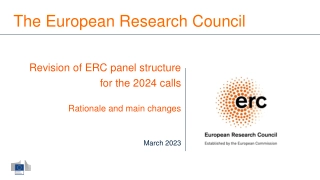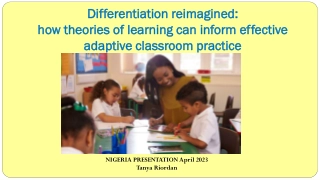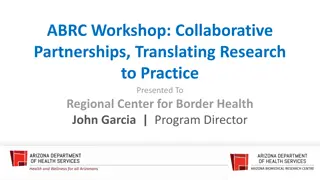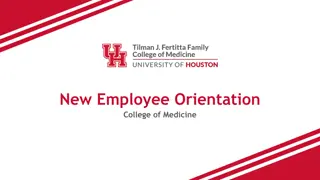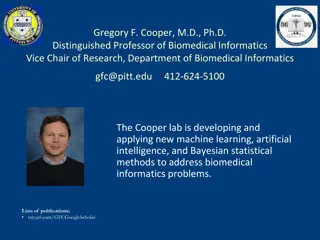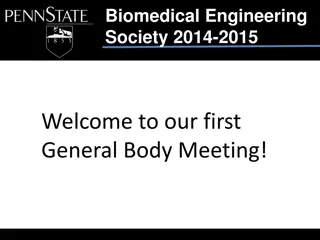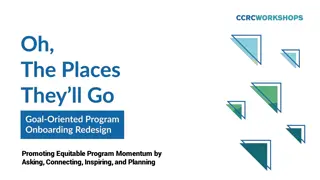Reimagining Evaluation in Biomedical Sciences
Large numbers of PhDs in biomedical sciences face uncertainty in career prospects post-graduation. Many aspire to tenure-track jobs but few actually secure them. The prevalent use of bibliometrics heavily influences career pathways. Paula Stephan's research highlights the need to rethink evaluation criteria for early career scientists to address these challenges.
Download Presentation

Please find below an Image/Link to download the presentation.
The content on the website is provided AS IS for your information and personal use only. It may not be sold, licensed, or shared on other websites without obtaining consent from the author.If you encounter any issues during the download, it is possible that the publisher has removed the file from their server.
You are allowed to download the files provided on this website for personal or commercial use, subject to the condition that they are used lawfully. All files are the property of their respective owners.
The content on the website is provided AS IS for your information and personal use only. It may not be sold, licensed, or shared on other websites without obtaining consent from the author.
E N D
Presentation Transcript
How Can We Change Evaluation of Early Career Scientists? Paula Stephan Georgia State University and NBER October 2019
Six Facts Large and growing number of PhDs are produced in the biomedical sciences in the US annually: 8500 in 2017, up from 7200 in 2007 Large percent do not have definite commitments at the time they graduate Largest percent with definite commitments take postdoctoral positions upon graduating Large percent of postdocs aspire to tenure-track jobs in academe Very small percent will actually obtain tenure-track jobs Bibliometrics play a large role along the way
Six Facts Large and growing number of PhDs are produced in the biomedical sciences in the US annually: 8500 in 2017, up from 7200 in 2007 Large percent do not have definite commitments at the time they graduate Largest percent with definite commitments take postdoctoral positions upon graduating Large percent of postdocs aspire to tenure-track jobs in academe Very small percent will actually obtain tenure-track jobs Bibliometrics play a large role along the way
Facts Large and growing number of PhDs are produced in the biomedical sciences in the US annually: 8500 in 2017, up from 7200 in 2007 Large percent do not have definite commitments at the time they graduate Largest percent with definite commitments take postdoctoral positions upon graduating Large percent of postdocs aspire to tenure-track jobs in academe Very small percent will actually obtain tenure-track jobs Bibliometrics play a large role along the way
Facts Large and growing number of PhDs are produced in the biomedical sciences in the US annually: 8500 in 2017, up from 7200 in 2007 Large percent do not have definite commitments at the time they graduate Largest percent with definite commitments take postdoctoral positions upon graduating Large percent of postdocs aspire to tenure-track jobs in academe Very small percent will actually obtain tenure-track jobs Bibliometrics play a large role along the way
Majority of Postdocs Have Preference for Job in Academe Paula Stephan Georgia State University & NBER Sauermann & Roach: Why Pursue a Postdoc?
Facts Large and growing number of PhDs are produced in the biomedical sciences in the US annually: 8500 in 2017, up from 7200 in 2007 Large percent do not have definite commitments at the time they graduate Largest percent with definite commitments take postdoctoral positions upon graduating Large percent of postdocs aspire to tenure-track jobs in academe Very small percent will actually obtain tenure-track jobs Bibliometrics play a large role along the way
Tenure and Tenure-track Positions 3-5 Years Since PhD 10.6% biological, agricultural and environmental sciences; (17.3%) 14.3% physical sciences; (18.8%) 14.6% engineering; (22.7%) 13.8% computer and information sciences; (55.7%) 29.6% math and statistics; (54.9%) Red is 2013; Blue is 1993; Table 3-16 Indicators. Paula Stephan Georgia State University & NBER
Increase in Non-research, Non-academic Positions; Decline in Tenure-Track Positions
Facts Large and growing number of PhDs are produced in the biomedical sciences in the US annually: 8500 in 2017, up from 7200 in 2007 Large percent do not have definite commitments at the time they graduate Largest percent with definite commitments take postdoctoral positions upon graduating Large percent of postdocs aspire to tenure-track jobs in academe Very small percent will actually obtain tenure-track jobs Bibliometrics play a large role along the way
Role of Publications in Top Journals Publications especially first authored articles in high impact journals-- are seen as a necessary condition for getting out of postdoc jail into an academe position Paula Stephan Georgia State University & NBER
More Generally Bibliometrics especially short term bibliometrics--play large role in Hiring Third year review Evaluation of grants Promotion
Short Term Bibliometrics and Risk Aversion Heavy reliance on short-term bibliometric measures arguably encourage risk aversion when it comes to funding individuals as well as hiring and promoting people who take risk Can be seen in work we did on novelty Paula Stephan Georgia State University & NBER
Blinkered by Bibliometrics Comment in Nature with coauthors explores concern of how bibliometrics reinforce risk aversion and affects early-career researchers Jian Wang Reinhilde Veugelers Nature Comment, April 26, 2017 Paula Stephan Georgia State University & NBER
Premise Novel research that combines streams of knowledge never combined before is risky; more likely to be frontier shifting; also more likely to fail Operationalize it by looking at number of first ever journal pairs in references of papers published in 2001 Find novel research is rare 11%; highly novel, much, much rarer Novel research has a higher citation mean and higher variance More likely to be top cited but also more likely to fail in terms of receiving few citations Paula Stephan Georgia State University & NBER
Findings Paula Stephan Georgia State University & NBER
Implication Heavy reliance on short term bibliometric measures (such as Impact Factors) and recent citations biases decisions against investigators doing novel research Yet some funding agencies require such bibliometrics be reported in the grant; some encourage it but do not require it Hiring committees look at such metrics; deans and provosts look at such metrics in third-year review and promotion AI encourages the use of such metrics Paula Stephan Georgia State University & NBER
Extend Research by Examining Relationship of Novelty to Receiving an ERC Grant Know all recipients and sample of applicants who did not receive a grant Distinguish between those who have done novel research in the past vs those who have not Find those without a history of novel research are more likely to be funded than those with a history of novel research, holding other things constant Result is for early career program
Most Importantly Stabilize the biomedical workforce PhD programs and postdoctoral programs are used as inexpensive ways to get the research done; Creates unreasonable amount of competition for a limited number of research positions that are allocated on bibliometric measures There are other ways to get the research done Time to create increased number of staff scientists positions and quit growing the supply of PhDs for research positions that are unlikely to materialize
What Can Be Done at Universities? Need to dedicate more resources to evaluation by READING not COUNTING Educate deans and provosts to downside of bibliometrics especially short term bibliometrics Require applicants for positions and promotion to submit packet of their best not everything Stress research portfolio as important criteria; not metrics of accomplishments
More Generally Create journals for failed research Deescalate the arms race rankings are absolutely killing the research enterprise! Overreliance on university model as host for research; consider moving some research to institutes not affiliated with universities Consider different funding models Lottery? We are spending huge amounts of time writing and evaluating proposals (Carl Bergstrom)
Generate Good, Reliable Placement Data Undergraduates need to know career prospects before going to graduate school Some progress is being made here Under leadership of Ron Daniels, President of Johns Hopkins, Chair Next Generation NAS Committee
Coalition for Next Generation of Life Scientists Formed while NAS Next Generation committee was meeting Brings together 37 institutions with a commitment to make career data available Coalition Data already available for some institutions UCSF
Thank you! Questions/Comments pstephan@gsu.edu


